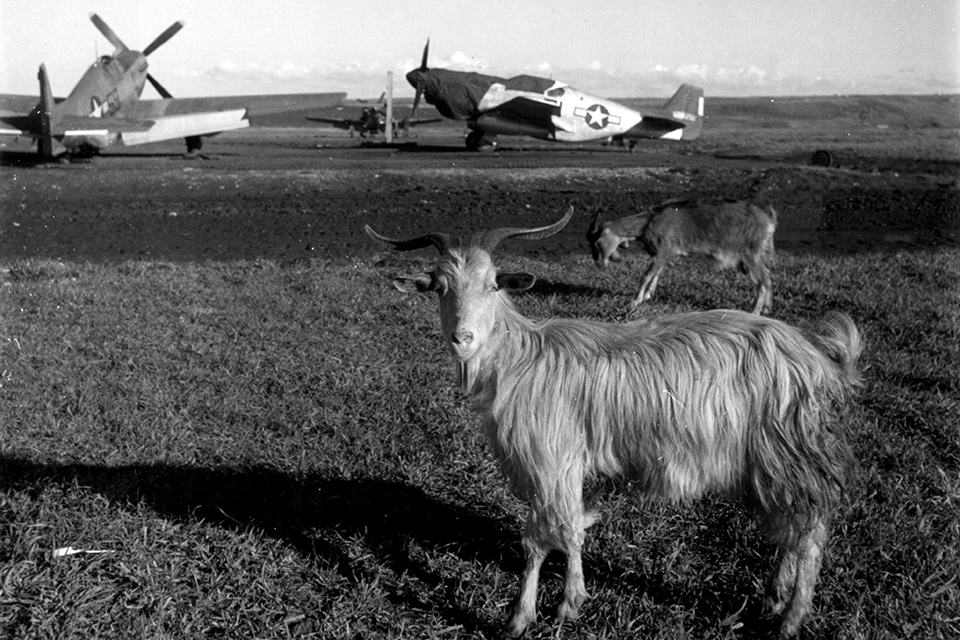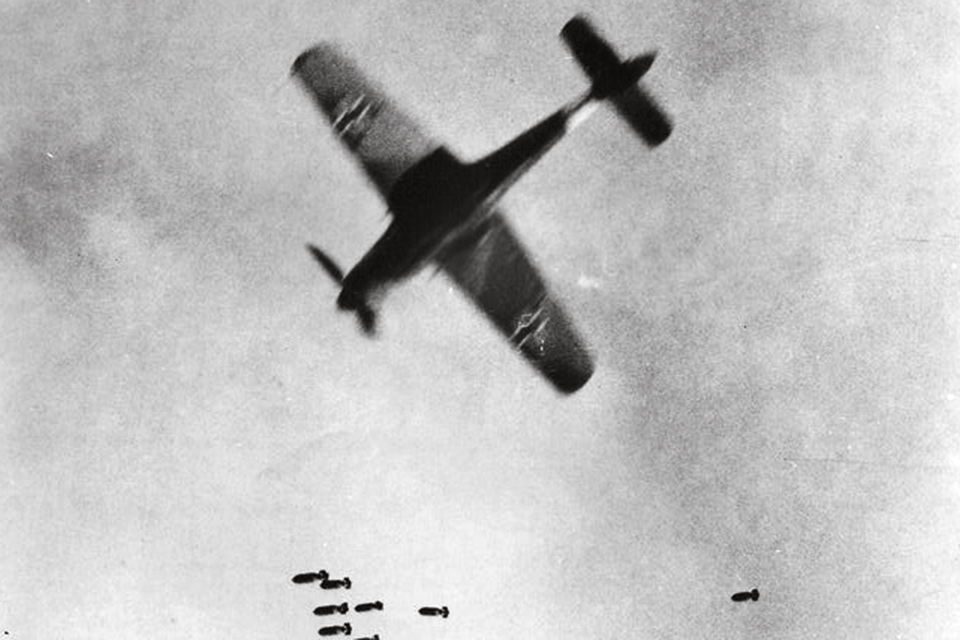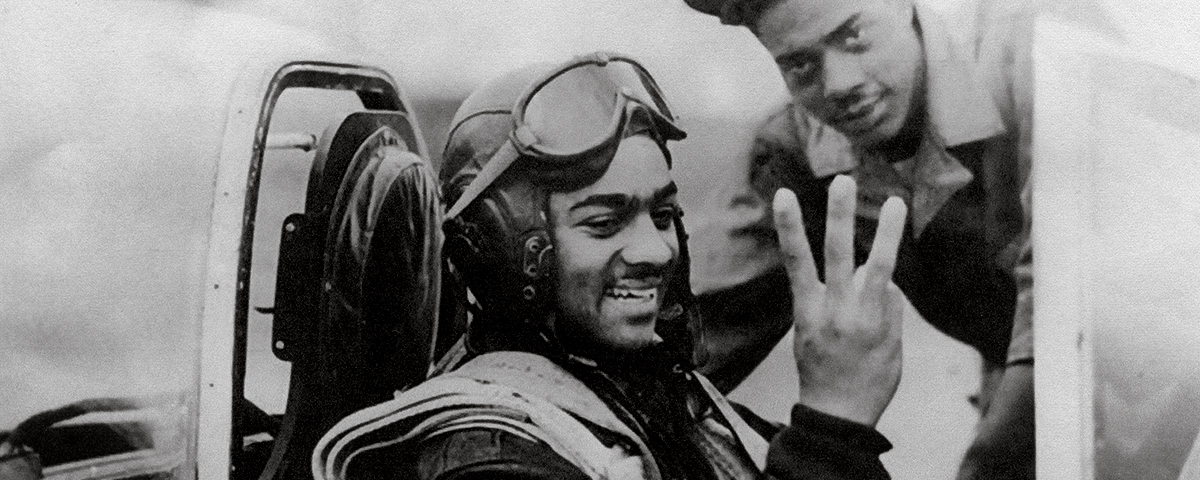Given the immense obstacles faced by black Americans who aspired to fly in World War II, obtaining the Army’s coveted silver wings at Tuskegee Army Airfield on June 27, 1944, was a remarkable accomplishment for Harry T. Stewart Jr. But the greatest test for the newly minted pilot lay ahead. The manner in which Stewart and his comrades acquitted themselves in the unforgiving crucible of the air war would burnish their reputation as outstanding fliers and patriots.
After earning his wings, Stewart accumulated an additional 80 hours in P-47 Thunderbolts at Walterboro, S.C., in preparation for his deployment overseas. An uneventful voyage to France was followed by yet another cruise—the source of fond memories to this day. Onboard the luxury liner Citie Doran, en route from Marseille to the Italian port of Taranto, immaculately attired stewards waited on Stewart and his squadron mates. He recalled it was more than a little awkward to have caricatures of the stereotypical English butler all but bowing to their every whim as they sailed to a war zone, shortly to be thrust into combat.
Once the airmen arrived, in early January 1945, their accommodations changed dramatically. They were herded into dirty, malodorous boxcars destined for Naples. Then trucks carried them to the air base at Ramitelli.
Ramitelli had become the operational nerve center for the all-black 332nd Fighter Group and its four squadrons the preceding summer. Fortunately for Stewart, the veteran pilots in the 301st Fighter Squadron took him under their wing. They mentored the newcomer as only grizzled combat fliers could, filling in the gaps in his training so that when his time came to face the Luftwaffe in eyeball-to-eyeball encounters, he would be ready.

Indeed, when asked about his heroes during a panel discussion of Tuskegee Airmen in 2012, Stewart turned to those seated around him and said quietly: “These gentlemen up here with me now. They were there for me; they are my heroes.”
By the time Stewart arrived in-theater, the 332nd had been assigned to the Bari, Italy-based Fifteenth Air Force, which—in sync with the Eighth Air Force operating out of England—was pressing the strategic bombing campaign into the enemy’s home territory. Since the 332nd was flying P-51 Mustangs with distinctive red tail markings, the black fliers became known as the “Red Tails.”
The missions in which they regularly participated involved hundreds of B-17s and B-24s, layered in massive formations. From Stewart’s aerie, riding shotgun well above these flying armadas, the sheer magnitude of the assemblage was awe-inspiring, especially on missions where, as a junior member of his squadron, he flew as Tail-end Charlie. Years later, his eyes beaming as he reminisced, Stewart said it was “a sight to behold.”
Of his 43 combat missions, none resonates in his memory as vividly as the one he flew on April Fool’s Day 1945. The briefing called for his element of eight Mustangs to lead a Liberator formation of the 47th Bomb Wing over the railway marshaling yards at St. Polten, Austria. Once the bombers reached the target area, Stewart and his squadron mates veered west to a Luftwaffe air base near Wels, to look for targets of opportunity.
One of the pilots in Stewart’s element called out four German fighters below, not far from the air base. “Our eight Mustangs cranked over in a mass dive on the enemy aircraft,” Stewart recalled. Suddenly, though, the hunters became the hunted. “The sky filled with at least another dozen fighters bearing Luftwaffe insignia,” he remembered. The low-flying fighters were decoys, used to lure the Americans into an ambush.
Barely out of his teens and facing his first dogfight, Stewart was initially almost overwhelmed by his emotions. There was anger at having been suckered into a trap, accompanied by terror at the high-stakes duel about to unfold. But then his survival instinct kicked in, with fear and doubt giving way to determination, bolstered by the young airman’s training and talent.
Stewart fastened his eyes on an enemy two-ship element beneath him. He dived toward his prospective quarry as skirmishes broke out around him. As he bore down on the enemy planes, he saw that they were long-nosed Focke-Wulf Fw-190Ds, the finest piston-powered fighters in the Luftwaffe’s arsenal. Closing to firing range, Stewart first concentrated on the nearest aircraft, squeezing off a few short bursts of .50-caliber rounds from his six wing-mounted machine guns. Smoke and flames quickly erupted from the enemy fighter.
When the second Luftwaffe pilot realized what had happened to his wingman, he yanked his plane into a hard right turn, trying to shake off the American. But Stewart turned just as tightly, pulling high Gs that stretched his P-51 to its limits. In the space of a fleeting second, the Tuskegee Airman trained his sight on the tail of the fleeing German. It was sufficient to squeeze off one more burst. An instant later, the German plane started to disintegrate “in a cloud of black smoke and orange flame just like the first one.”

Stewart had scored his second victory of the day, but just then he heard a squadron mate’s call: “Bandit on your tail!” Tracers whizzed past his cockpit, frightfully close. The sinking feeling in the pit of his stomach returned, but as before the survival instinct came to his rescue.
This time he used the Mustang’s speed in his own defense, dashing to the deck. The Focke-Wulf pilot on his tail was tenacious, much as Stewart had been moments earlier. With an enemy glued to his six, Stewart reefed his mount over into an extreme right turn—a desperate maneuver. The German followed, turning and turning in a test of strength and will.
With the men and machines ratcheted up to their limits, something had to give. Suddenly Stewart realized he was free of his pursuer. Looking back, he spotted the Fw-190 cartwheeling across the ground, then exploding in a ball of fire.
Stewart and his squadron mates who had witnessed the episode later speculated that the German had either stalled or snap-rolled too low to the ground. Perhaps he had become so fixated on Stewart’s Mustang that he simply failed to pull up in time over the undulating terrain. Whatever the cause, Stewart had racked up three victories during his first dogfight, earning the Distinguished Flying Cross.
Stewart remained in the Army Air Forces after the war in Europe ended five weeks later. In May 1949, he participated in the first U.S. Air Force gunnery meet, in which his Tuskegee Airman team won the “top gun” trophy for propeller planes (see “Tuskegee Top Guns”). Soon afterward he left active duty, but he retained his commission in the reserves, eventually retiring as a lieutenant colonel.
After earning a mechanical engineering degree from New York University, Stewart went on to a successful career with Bechtel Corporation in San Francisco and ANR Pipeline Company in Detroit. In 2007, when the Tuskegee Airmen were awarded the Congressional Gold Medal, he was among the half-dozen fliers on hand to accept on behalf of all who had played a part in the pioneering program. Today, on good flying days, Stewart can be found at Detroit’s airport, mentoring inner-city youth and sharing his love of flying with a new generation.
Originally published in the September 2013 issue of Aviation History. To subscribe, click here.





